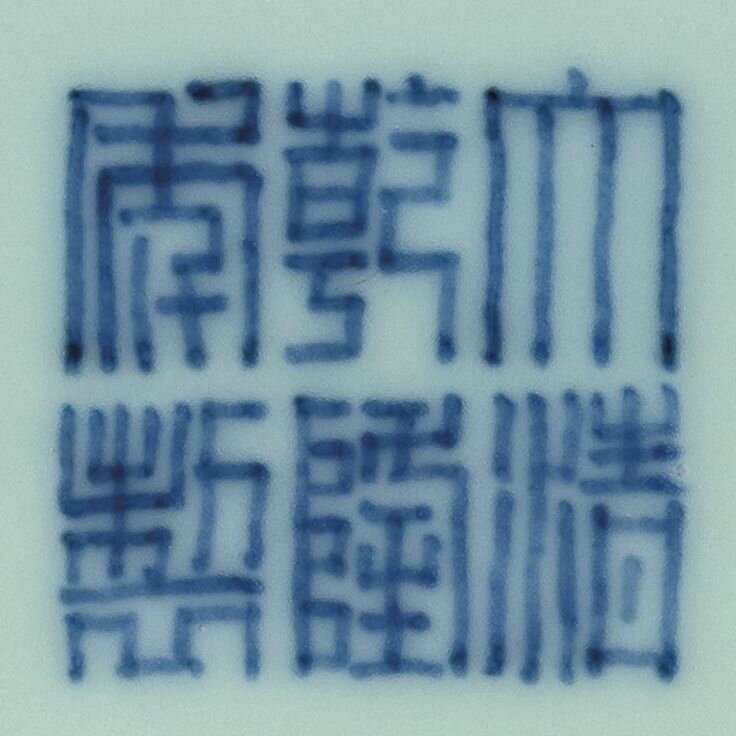A fine and rare celadon-glazed vase, Seal mark and period of Qianlong (1736-1795)
Lot 3115. A fine and rare celadon-glazed vase, Seal mark and period of Qianlong (1736-1795); 37.9 cm., 14 7/8 in. Estimate 8,000,000 — 10,000,000 HKD. Lot sold 9,680,000 HKD (1,248,720 USD). © Sotheby's
sturdily potted with a rounded body rising from a splayed foot to a waisted neck and flared rim, the voluptuous body divided into four bracket foliations and applied overall save for the footring with an unctuous celadon glaze of a pale sea-green colour, the base inscribed in underglaze-blue with a six-character seal mark.
Provenance: Collection of Taji Shuichi.
Bibliography: Taji Shuichi, Porcelain of the Ch'ing Dynasty, Tokyo, 1983, pl. 68.
Note: This rare vase is remarkable for its exquisite luminous glaze, the purity and depth of which accentuates the graceful curves of its profile. With its broad mouth that sweeps up from its flared foot, the potter has skilfully created a sense of movement and rhythm. It is an impressive example of the remarkable technical developments made to meet the specific taste of the Qianlong Emperor, which was characterised by the imitation of antiques, innovation and flair.
Vases of this type first appeared during the Yongzheng reign and are likely to be a product of Tang Ying (1682-1756), the superintendent of the Imperial kilns in Jingdezhen during the Yongzheng and early Qianlong period. A Yongzheng prototype of this vase, in the Palace Museum, Beijing, is illustrated in Qingdai yuayo ciqi, vol. 1, pt. II, Beijing, 2005, pl. 160. While the forms of the two versions are closely related, the former has a heavier appearance due to its opaque Ru-type glaze.
Tang Ying introduced simplicity of form and the absence of decoration as the new stylistic trends following research into celebrated Song glazes such as guan, ge, and Longquan celadon. During the Qianlong period, the style and taste largely continued in the heritage left by his father, with the tendency to elaborate on earlier models. Like his father he was enamoured with archaistic designs but the revivals of his time more typically followed Yongzheng prototypes than reinventing the Song or Ming antiquities. For the possible Song inspiration to this vase, see a small pear-shaped Longquan celadon example sold in our London rooms, 13th December 1988, lot 123, and a guan-type vase illustrated in George J. Lee,Selected Far Eastern Art in the Yale University Art Gallery, New Haven, 1970, pl. 37.
Several celadon varieties were developed by Tang Ying which he recorded in the list of porcelains produced by the imperial kilns composed in 1735. One of his successful recipes was to study in detail the finest antique ceramics of the Song and Ming periods to understand their workmanship and physical quality, as well as to comprehend what made their shapes and designs so harmonious and satisfying, and then to apply his knowledge to completely redesigned, modern versions inspired by the antiques. This subtle glaze has been produced in imitation of Longquan celadon of the Song period and the delicate, almost watery tone was a Kangxi innovation which was produced by lessening the amount of iron typically found in Song dynasty Longquan celadons. The glaze was further modified during the Yongzheng and Qianlong periods to the fine bluish tone as seen on the present vase.
The form of this vase invokes two ancient bronze forms in one to transform the piece into an innovative 18th century design. The wide flared neck and foot with bulbous body are reminiscent of archaic bronze zun while the vertical lobes give the impression of the pear-shaped hu. Furthermore, the angular edge running down each side of the body give the impression of sections that have been joined together on large metal-bodied vessels. Together with the luscious celadon glaze, this vase bears resemblance to a celadon-green jade vase which appears to combine the zun with a gu, and flanked with elephant handles, sold twice in these rooms, 29th October 2001, lot 706, and again, 24th October 2009, lot 1827, from the Water, Pine and Stone Retreat Collection.
Sotheby's. Imperial Porcelain and Works of Art from a Hong Kong Private Collection, Hong Kong, 07 april 2015, 10:15 AM

/https%3A%2F%2Fprofilepics.canalblog.com%2Fprofilepics%2F1%2F0%2F100183.jpg)
/https%3A%2F%2Fstorage.canalblog.com%2F03%2F02%2F119589%2F96711876_o.jpg)
/https%3A%2F%2Fstorage.canalblog.com%2F11%2F31%2F119589%2F94773502_o.jpg)
/https%3A%2F%2Fstorage.canalblog.com%2F20%2F83%2F119589%2F94772815_o.jpg)
/https%3A%2F%2Fstorage.canalblog.com%2F26%2F72%2F119589%2F75604929_o.jpg)
/https%3A%2F%2Fstorage.canalblog.com%2F59%2F60%2F119589%2F26458628_o.jpg)






/image%2F1371349%2F20240402%2Fob_7227e1_129-1.jpg)
/image%2F1371349%2F20240329%2Fob_2076ee_113-1.jpg)
/http%3A%2F%2Fstorage.canalblog.com%2F92%2F58%2F119589%2F129772574_o.jpg)
/http%3A%2F%2Fstorage.canalblog.com%2F50%2F04%2F119589%2F129632031_o.jpg)